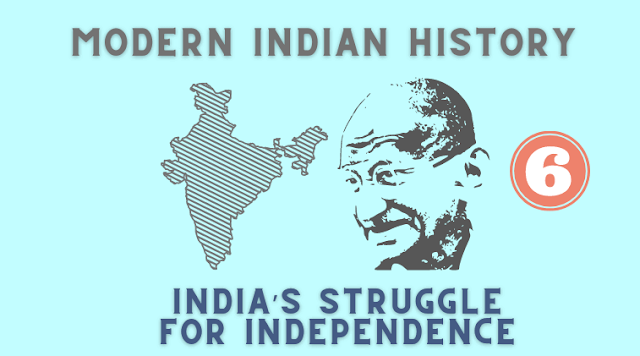Describe the various forms which the popular protests took between 1945 and 1947
Describe the various forms which the popular protests took
between 1945 and 1947. The Indian freedom development was a progression of
notable occasions with a definitive point of finishing English rule in India.
It endured from 1857 to 1947.
The primary nationalistic progressive development for Indian
freedom rose up out of Bengal. It later flourished in the recently shaped
Indian Public Congress with conspicuous moderate pioneers looking for the
option to show up for Indian Common Help assessments in English India, as well
as additional monetary privileges for locals. The principal half of the
twentieth century saw a more extreme methodology towards self-rule by the Lal
Bal Buddy magistrate, Aurobindo Ghosh and V. O. Chidambaram Pillai.
Describe the various forms which the
popular protests took between 1945 and 1947
The last phases of the autonomy battle from the 1920s was
described by Congress' reception of Mahatma Gandhi's approach of peacefulness
and common insubordination. Learned people like Rabindranath Tagore, Subramania
Bharati, and Bankim Chandra Chattopadhyay spread enthusiastic mindfulness.
Female pioneers like Sarojini Naidu, Pritilata Waddedar, and Kasturba Gandhi
advanced the liberation of Indian ladies and their cooperation in the
opportunity battle.
Not many pioneers followed a more brutal methodology. This
turned out to be particularly famous after the Rowlatt Act, which allowed
endless confinement. The Demonstration ignited fights across India,
particularly in the Punjab area, where they were fiercely smothered in the
Jallianwala Bagh slaughter. Describe the various forms which the popular
protests took between 1945 and 1947.
The Indian autonomy development was in steady philosophical advancement. Basically hostile to pioneer, it was enhanced by dreams of free, monetary improvement with a mainstream, majority rule, conservative, and common freedom advocate political design. After the 1930s, the development took on areas of strength for a direction. It finished in the Indian Autonomy Act 1947, which finished Crown suzerainty over India and made Pakistan.
Describe the various forms which the
popular protests took between 1945 and 1947
Describe the various forms which the popular protests took
between 1945 and 1947. India stayed a Crown Domain until 26 January 1950, when
the Constitution of India laid out the Republic of India. Pakistan stayed a
domain until 1956 when it embraced its most memorable constitution. In 1971,
East Pakistan pronounced its own autonomy as Bangladesh
The period between 1945 to 1947 was that of a serious battle
in the Indian subcontinent. It has been depicted differently as the birth aches
that prompted the twin nations being shaped.
is period in context, it's a good idea to begin with the job
of the English. The place of the colonialists was to some degree shaken post
the 1945-1947 political improvements regarding the world. At this point not the
supreme power that it used to be, England was currently more open to
"permitting" Autonomy or some type of home rule.
In the mean time, the political environment in India had
fundamentally changed too. There was presently a developing criticalness in
thoughts of self rule, the exchange of force from the colonialists into Indian
hands. Most of Indian Public Congress pioneers in this way wound up let out of
prison, and different types of political authority.
Describe the various forms which the
popular protests took between 1945 and 1947
Plus, there was enormous scope preparation of individuals
too, There were huge exhibits, uprisings, and so on. There was an expanded
degree of mindfulness that opportunity was ever closer undeniable level
discussions were occurring.
The period from 1900-1940 had been about public freedom. This
was anyway made more intricate by a different call for Muslim self-government.
The interest for another different nation was in progress also and this new
region was to be named Pakistan.
This thought of Pakistan didn't, as per pundit Gyanendra
Pandey, have an extremely lengthy history. However, it was essential for the
two-country hypothesis. It was exclusively in the Walk of 1940 that the Muslim
Association proposed the foundation of isolated states for Muslim greater part
areas.
The late spring of 1946 saw a transient understanding between
the Indian Public Congress and the Muslim Association. This was in regards to
the Bureau Mission intend to set up a free government state - Hindu and Muslim,
with a plan to survey it consistently.
Describe the various forms which the
popular protests took between 1945 and 1947
The Muslim Association, in any case, leaned toward what it
called "direct activity." This period was set apart by outrageous
uproars among Hindus and Muslims. While beginning in Calcutta, they spread to
Bombay, Uttar Pradesh, North West Outskirts Region, what are currently the two
Punjabs, and so on.
Probably the most tormenting and blood twisting pictures of
the Segment come from this period - much before the drawing of the Radcliffe
line. While discussing the historical backdrop of India, we tend frequently to
fail to remember that what is currently Pakistan and what is presently India
were really one land. We fail to remember the brutalities that split the two
nations, similar as the agonies related with the partition of Siamese twins. Describe
the various forms which the popular protests took between 1945 and 1947.
ALSO READ:-
The Congress Ministries Between 1937 And 1939







0 comments:
Note: Only a member of this blog may post a comment.